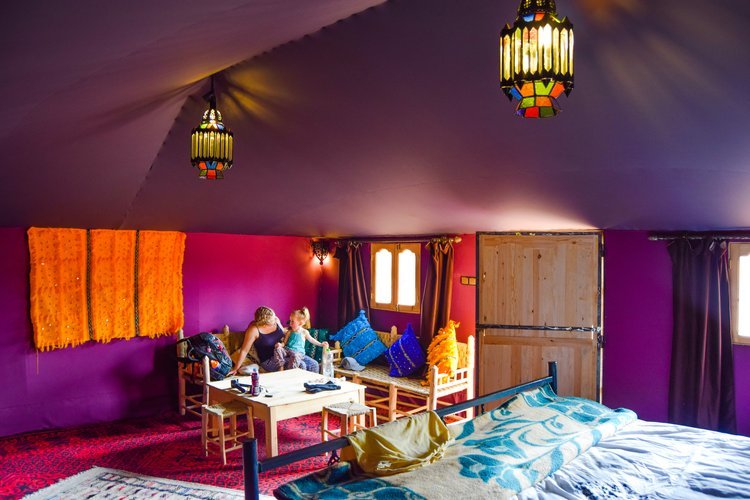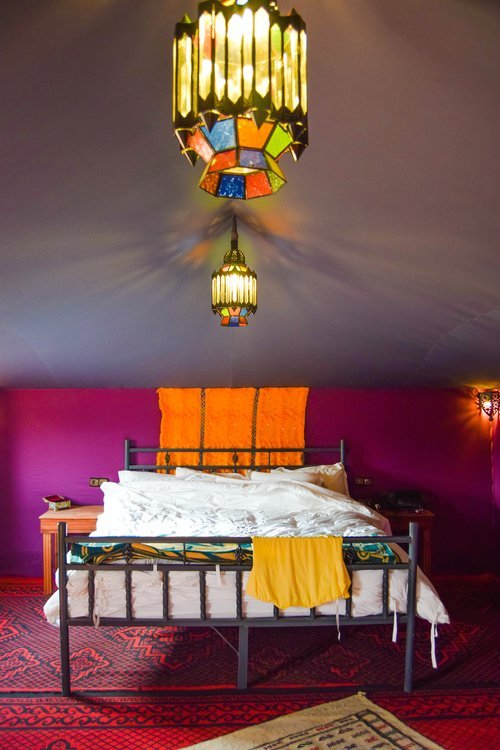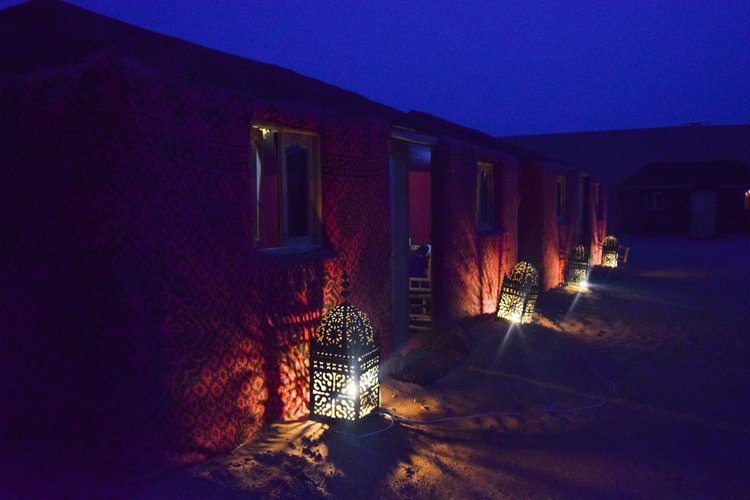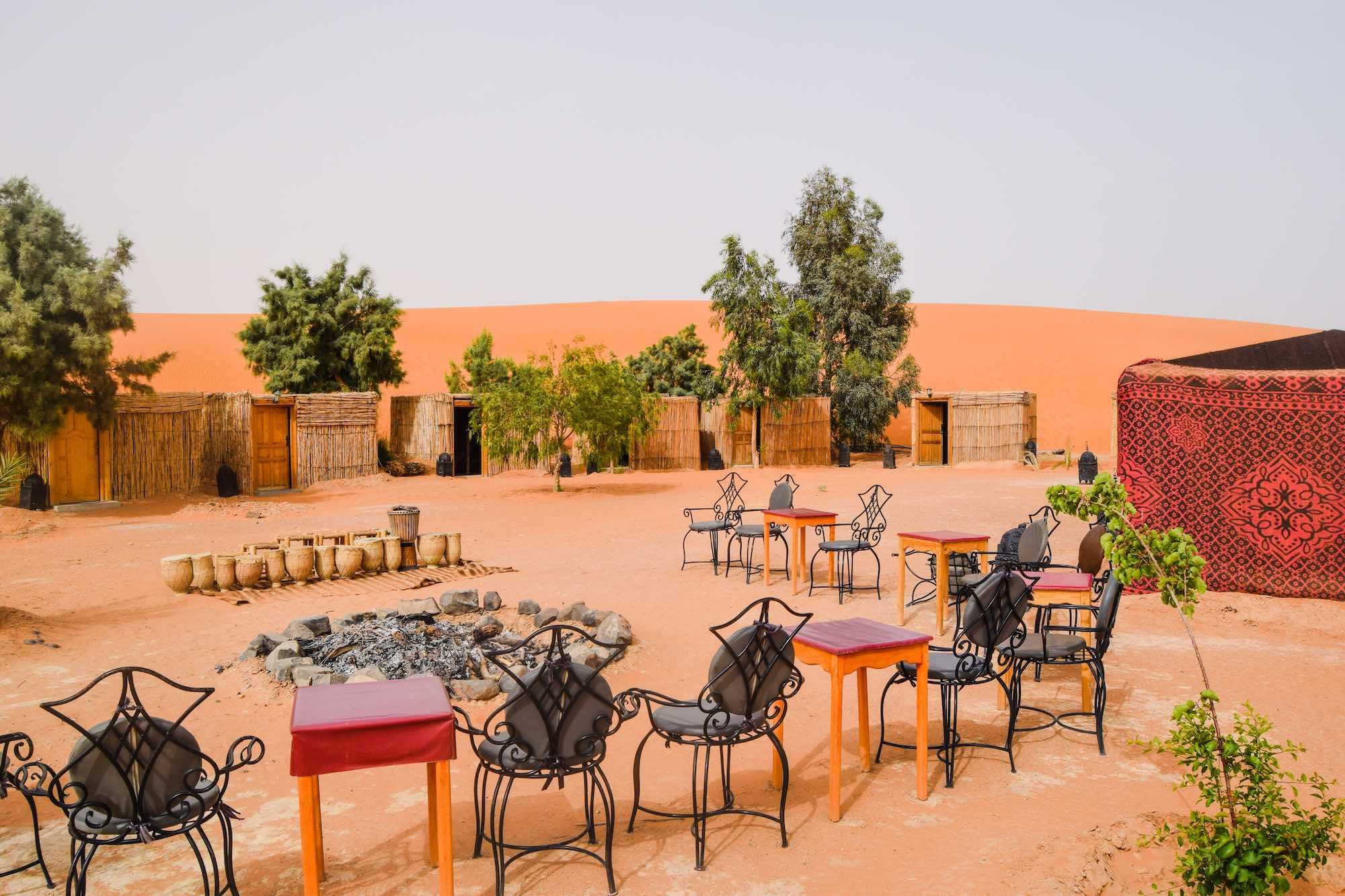The Sahara Desert With Kids - Our Ultimate Family Guide
Is the Sahara Desert worth visiting?
We won’t lie and tell you that visiting the Sahara Desert in Morocco is a piece of cake, as it does takes some careful planning and patience, especially for those travelling with children, however, it is a journey offering unique opportunities, which we believe is definitely worth putting in the extra effort to see. Not only is it one of the most majestic landscapes on the planet, which will truly captivate both adults and children, but it will also provide a unique experience to learn more about the environment and way of life of the Berbers living in the desert. Let’s not forget to mention that, through the eyes of a child, it’s literally the world’s biggest sand pit! What’s not to love?
For us, it was a bucket list destination we knew we had to tick off while backpacking Morocco, so we were prepared to put in the time and effort to fully research and understand this leg of our journey and all of the options available to us. Rest assured, we’ve done most of the hard work for you, so read on, to better understand how to turn your Sahara Desert dream into a reality with you and your family.
Desert safari with kids, watching a camel
Where is the Sahara Desert in Morocco?
The Sahara Desert runs from north to south, down the Eastern side of Morocco, near the closed border with Algeria. Anyone wishing to visit needs to make their way to one of Morocco’s main Ergs, translating as ‘sand sea,’ which is the area where the sand dunes are located. With Morocco’s two main Erg’s being Erg Chebbi and Erg Chigaga, the next question is, which is the best Erg to visit?
Erg Chigaga or Erg Chebbi?
Erg Chigaga
Erg Chigaga is renowned for being the more underdeveloped of the two destinations, which offers a distinctly more adventurous and isolated experience for travellers. This is due to the area being located 60km from the nearest small town of M’hamid, which means that although it’s slightly closer to Marrakech, at a 9-hour drive, compared to its competitor Erd Chebbi, which is a 10-hour drive, visitors have to transfer to a 4x4 for the final 2 hours in order to make their way across barren rocky desert until they get to the impressive dunes. Also, the nearest airport to M’hamid is Ouarzazate Airport, which stands at a 4-hour drive away. This for some, would be the optimal experience, well off the beaten path, less tourists visiting the area, due to the difficulty of getting there, but still the option to do a quality desert safari. For us, however, travelling with a toddler, we preferred to not be too isolated and far away from a more developed town, just in case of the worst-case scenario, an emergency.
Erg Chebbi
Erg Chebbi is the most popular of the dunes, due to the fact that it is far more accessible to get to, with the main town in the area, called Merzouga, being right on the doorstep of the dunes, so much so, that it is called the gateway to the Sahara. You have the opportunity to utilise the modern hotels within the town, also known as kasbahs, after a long day traveling to the area, or after completing your desert safari, before leaving the area. Some have swimming pools, which is a huge positive if travelling with children, with a few even having their pools overlooking the desert with amazing views. Merzouga is a short 4v4 drive or camel ride to get to the 150m high dunes, and under a 2-hour drive to get to the closest airport, Errachidia. For this reason, we opted to visit the Sahara here, for the convenience and peace of mind this gave us travelling with a child,
Enjoying the sand in the Sahara Desert with kids
Best time to visit the Sahara Desert / Merzouga weather
You may be imagining a scorching desert and wondering if it’s a bad idea to take children into such an environment. You’ll be pleased to know that although the summer months of June, July, and August are absolutely sweltering in the Sahara Desert, reaching up to 55 degrees Celsius, at other times of the year, the weather is much more accommodating. The best time to visit the Sahara Desert is in the autumn months of October and November and the spring months of March to May, when daytime temperatures are normally lower, ranging between 21 to 26 degrees Celsius. As soon as the sun starts to go down, the Sahara Desert at night drops considerably in temperature, with winter nights in December and January going below freezing, which is another reason to visit in the autumn or spring, when evenings are cool, yet still comfortable. We visited the Sahara in April and found the Merzouga weather to be warm and evenings cooler, where we had to put on a jacket to keep the chill off us, but nothing too extreme.
Running across the Sahara Desert
How to visit the Sahara Desert in Morocco
With our choice of Erg highlighted, let’s now explain, how to get to Merzouga, as there are a number of different travel options you can choose between:
Sahara Desert Tour
Anyone feeling slightly nervous about visiting the area, or short on time in planning/ booking the trip, may wish to go with a reputable tour operator and have a company organise all of your travel, accommodation and desert safari activities, along with providing a guide to accompany you. Most tour operators will pick up from either Marrakech or Fes and drive to the desert, with stops at points of interest en route.
We prefer to steer away from this travel option, as one, it ramps up the cost of travel, for a trip that you could do far cheaper by booking it directly yourself. Two, you often have to travel with a larger group, which isn’t ideal when travelling with children, and we always prefer the flexibility to plan our days according to our own preferences, for example, meal times, snack times, nap times and downtime when it suits our family. Not to mention that sometimes half the stress of travelling with children can sometimes be having to keep them on their best behaviour, so they don’t spoil other travellers’ experiences, with toddler meltdowns at the most inappropriate times, and yes, believe it does occasionally happen! Travelling separately from a tour group allows us to experience travel in our own unique way, at our own time and it’s far better.
Self-drive to the Sahara Desert
Some prefer to venture to the other side of the spectrum, hiring a car and driving to the Sahara all by themselves, for optimum freedom. This allows tailoring the journey to personal preferences, stopping off for breaks when they are needed, or in case something of interest catches the eye. It also allows continuing to drive onto a different part of Morocco after the desert safari has finished, compared to the area which was set out from, before the safari. For example, a popular self-drive route is departing from Fes or Marrakech, visiting the desert and then continuing onto the High Atlas Mountains afterwards.
Although we opted to self-drive throughout most of our Morocco trip, we decided against a self-drive for this leg of our journey, primarily because we were a little sceptical of driving through desert terrain, in case we broke down or got lost in the middle of nowhere. We had also planned to visit the High Atlas mountains after the desert and the 10-hour plus drive from Merzouga to the mountains in such a short space of time that we had, was also not very appealing. We got around this issue with a private transfer down to the desert and then a flight out of the area, which we have explained next. For this to happen, we dropped our hire car off in Fes, after using it for the whole first part of our trip from Marrakesh, to Chefchaouen, to Fes, and had to pay a small additional fee to the hire company, to return it to a different location compared to pick up.
Private transfer to the Sahara Desert
If you are comfortable booking both your accommodation in Merzouga and your desert safari company directly, then we’d recommend getting a private transfer to the Sahara Desert. This was the option we chose, despite it being more expensive than the self-drive option. Leaving our hire car in Fes we paid a driver £250 to drive us 7 hours to Merzouga in a very comfortable people carrier. We felt at ease knowing if we had a breakdown or any issues, we were travelling with a local, who knew the roads well from doing the journey before. We feel we made the right decision, as the journey was very isolated in parts and breaking down en route would have been a nightmare! More importantly for us, we were adamant we didn’t want to drive on to the High Atlas Mountains due to the tediously long drive, so it gave us the option to instead fly out of the desert region, as we no longer had our hire car to worry about.
Fly to the Sahara Desert
Although there isn’t an airport in the Sahara Desert, you can fly low cost to and from Errachidia airport, which is only 2 hours away from Merzouga. The main options are either, a direct flight from Fes to Errachidia (or reversed), which takes 1 hour, or a flight from Marrakech to Errachidia (or reversed), which has a stop-off in Casa Blanca.
We decided to take the second flight option to Marrakech, as this was the closest airport to our next destination in Morocco, the High Atlas Mountains. The Errachidia to Marrakech flight departed at 08:05 am, taking 2 hours, followed by a short 1 hour 30 min layover in Casa Blanca, then onto the second flight to Marrakech, which took only 55 minutes. We arrived in Marrakech within 4 hours, just after midday, and found this travel option very convenient when travelling with a child, as Carmen was able to run around at the airport in between flights and it eliminated the 10-hour drive onto the High Atlas mountains, which would have been very testing with a toddler!
If you wish to fly out from Errachidia as we did, we suggest staying an additional night in Merzouga after your desert safari (or even in Errachidia) to enable you to get up in the early hours to check in for an early morning flight. We enjoyed our stay in Merzouga and found it allowed us to recoup after our desert safari, wash all the hidden sand off us and get a taste of the place.
Camel train through the Sahara Desert
Stop offs en-route to Merzouga
If travelling to Merzouga from Marrakech, there are a number of stops off’s you can make, to help break up the journey, even stopping over night in some of the following locations:
Ait Ben Haddou
A UNESCO World Heritage Site, which is a fortified village, also known as a ksar. You may recognise this place from being featured in a fair few movies, including Game of Thrones, Gladiator, Lawrence of Arabia, and The Mummy.
Ouarzazate
In this town you can visit the Atlas Studios, to tour old movie sets.
Todra Gorge
Although there is no river here now, you can see the impressive canyon that the rivers once created, which makes for a nice day stop, to stretch your legs.
How many days in the Sahara Desert?
From experience we'd recommend doing a minimum of 2 nights camping on desert safari, as we found our 1 night safari just wasn't long enough. We had 3 nights in the area in total, however, spent 1 night in a hotel in Merzouga on arrival, followed by 1 night on desert safari camping, finishing with 1 additional night in Merzouga (to allow us to fly out of Errachidia airport the next morning at 8 am - and free!). This disjointed stay in hotels and tents, made the experience a little stressful, with not being able to settle in more to the accommodations. As an alternative itinerary, we’d strongly suggest not arranging accommodation in Merzouga on night one, but instead heading straight into the desert with your safari guide, on the same day as arriving, followed by 1 night in Merzouga to recoup and wash all the sand off you. If you are on an even tighter time scale, you could complete your Sahara desert experience in 2 days only, driving onto your next destination straight after your 2 nights on safari. Your accommodation provider, however, will most likely need to drive you the short 15 minutes back to Merzouga, where you can also pick your car up if this is the transport option you decide to go with.
Exploring the Sahara Desert with kids
Where to stay in the Sahara Desert
Best Sahara Desert camp
So you’re wondering where the best Morocco Desert camp is? There are tons of options to choose from within Erg Chebbi, from luxury glamping accommodations to budget camps. We decided to go with a mid-range choice, Ali and Sara’s Desert Palace, and they provided everything we needed for a brilliant desert safari. They picked us up from our hotel in Merzouga, late morning and drove us out to their desert camp, where we had the afternoon to explore the camp, and the dunes and also eat lunch, which they provided. At sunset, they took us on a beautiful camel ride across the dunes, then provided dinner, followed by an authentic Berger drumming session around the campfire, which was magic! We had a great night’s sleep in their glamping tests, with a private bathroom, and then the following morning after breakfast, they drove us back to our hotel in Merzouga.
Click here to view accommodation.
Best hotel in the Sahara Desert
Merzouga has the biggest range of hotels in close proximity to the Erg Chebbi sand dunes. We’d recommend if budget allows, staying in one that has a swimming pool, especially if you’re travelling with children. We stayed in Kasbah Mohayut where we relaxed on either side of our desert safari, having fun in their swimming pool and keeping nice and cool.
Things to do in the Sahara Desert
Desert Safari
Immerse yourself amongst the dunes and stay for a few nights at a desert camp, enjoying the peace quiet, and charm of this fascinating place.
Overlooking Ali and Sara’s Desert Palace
Camel ride
We put this option in here depending on the environment and state the camels are in, which you have the option to ride. We originally didn’t want to ride any animals due to animal cruelty fears, but once we saw the good conditions the camels were kept in at our accommodation, we decided a 20-minute ride was ok in our opinion. The camels were allowed to rest all day with ample space and no fences and were only used to take guests to and from the sunset spot. If in doubt about the welfare of the camels, check their appearance to see if they have marks, scars, or cuts on their skin. If so they may be being hit and abused, our camels had smooth soft skin. Check they have clean eyes with no signs of their harness rubbing them. Check if they have access to drinking water and food. Our camels had fresh water and food throughout our whole stay with them. Use your common sense to judge how the owner interacts with them. Are they rough or aggressive? Our guide was calm and gentle to them and they in turn responded well to him and were at ease. He knew them each by name, showed them a lot of affection, and took the time to introduce us to them.
In terms of having a ride with children, we’d recommend only older children riding a camel by themselves, no younger than 10 years, due to it being incredibly bumpy and rather high off the ground. Our daughter was 2.5 years old when she went on one with an adult and it took strength to hold her safely at the front of the seat. We’d recommend letting the camel stand up first with the riding adult on its back, and have the guide pick up the child to pass them up to the adult. This is because camels straighten their back legs first when standing up, so it’s quite easy to fall forward if you don’t remember to lean back. Also, follow this rule for when you go down any sand dunes, or you may fall forward over the camel’s head. The best time for a camel ride is late in the afternoon when the sun is setting and it is noticeably cooler.
Camel safari across the Sahara Desert
Holding on tight on our camel safari
Watch the sunset/sunrise
Not only is sunset time a lot cooler as previously mentioned, but it is a time to see the most spectacular colors emerge over the dunes. Your desert safari hosts will no doubt know of the best spot to witness the sunset from, so make sure you ask them to show you in plenty of time. If there is a light sand storm, like there was when we visited the desert, it may be difficult to see the sunset properly, with it being so hazy.
Taking in the magnificent views of the Sahara Desert
Berber drumming & campfire
This was by far the highlight of our stay in the Sahara and lives on fondly in the memories of our daughter Carmen. After dinner be serenaded by live, traditional Berber music, around the campfire. You may like to sit back and watch as they perform, or you may be moved by the music so much so, that you just have to get up and dance to the rhythms like we did!
Campfire at Ali and Sara’s Desert Palace
Stargazing
On a clear night, it’s incredible to see how bright and prominent the stars are. Some camps give you the option to move your bed outside to sleep directly under the stars. You can also learn interesting astronomy from the nomadic people.
Sand surfing
Sadly we didn’t get time to do this on our first trip to the Sahara, but definitely plan on having a go when we return in the future. Imagine snowboarding, but the sand equivalent, well that’s exactly it. If your child is too young to stand up on the board and balance, let them sit down on it, even with an adult for extra support.
Jeep Safari / Dune Bashing
If the thought of traipsing back up the sand dunes every time you’ve slid down, fills you with dread, why not try hitting the dunes in a 4-wheel drive, driven by an experienced driver? It’s exhilarating and also perfect for those with children or mobility issues. Try and get the front seat if you can for the best views.
Quad biking
Try quad biking, which puts you in control of a small 4x4 vehicle, and have fun navigating the terrain, whilst following a guide.
Fossil hunting
Millions of years ago the Sahara desert was a sea, filled with sea creatures. Nowadays you can hunt for their remains, which have been fossilised. Going hunting for pre-historic sea creatures would excite most children.
Dayet Srij Lake
This place from December through to April is a lake, which dries out from May until November. Here you can see migrating birds enjoying the water and you may even see lots of pink flamingos, which tend to arrive between March and April. Don’t forget to take your binoculars.
Dayet Srij is a temporary lake that dries out from May to November – if the winter is not rainy the lake can dry out earlier. The way to the lake goes through a black stony desert. It creates a beautiful contrast to the blue sky and peach dunes on the horizon line.
Rissani Market
About 40 minutes drive from Merzouga you’ll find the town of Rissani, holding the largest market in the region every Tuesday, Thursday, and Sunday.
Morning views from our safari tent at Ali and Sara’s Desert Palace
What to take to the Sahara Desert
1. Suncream
2. Water - This should be provided by your desert camp, however always carry a spare bottle wherever you go.
3. Loose-fitted, comfortable clothes, with the option to cover all the arms and the legs, in case the wind whips up, as this causes the sand to blow, which can actually be quite painful, especially for children. You also need to wear trousers that won’t ride up on the camel ride, as the animal’s skin may cause irritation to the legs. socks are also a good idea to take.
4. Sun hat, especially for young children
5. Scarf to wrap around your head, to keep the sand off your face. You may be provided these by your desert camp for your camel ride.
6. A warm optional outfit, especially to wear at night, as the desert can get very cold.
7. Hand torch or better still a head torch. Most desert camps run on solar power, so in a bid to save energy, some turn their lights off when it’s bedtime.
8. Sunglasses
9. Portable charger to charge your electronics (just in case there is a power cut, or you are staying in a budget camp that is off the grid. Make sure you check in advance.)
10. Medication, eg Paracetamol, Calpol etc.
11. Camera (With a protective lens and bag as the sand gets everywhere.
12. For young children you could also take with you a small bucket and spade if space allows, this will keep them entertained for ages!
Taking in the views of the Sahara Desert
Where to eat in the Sahara Desert
Your food will most likely be provided by your desert camp, so remember to enquire in advance of food options, especially if travelling with children. Pack some snacks to take with you preferably from the main city, before arriving in Merzouga, and remember to get ones that don’t melt in the heat! Whilst at camp, we were offered a three-course meal for dinner comprising of vegetable soup for the starter, either a meat or vegetable tagine for the main, and fruit/ cake for dessert. For breakfast, there was cereal, eggs, fruit, and pancakes. Our two-year-old daughter Carmen tried a small amount of the adult’s food for dinner, however, we also packed a few food pouches, that could be placed in hot water to heat up, so on this night specifically she had spaghetti bolognese.
Wonderful staff at Ali and Sara’s Desert Palace



















